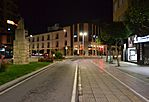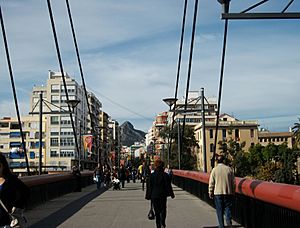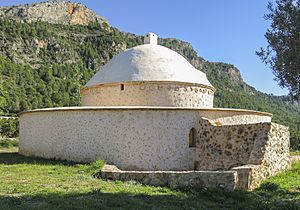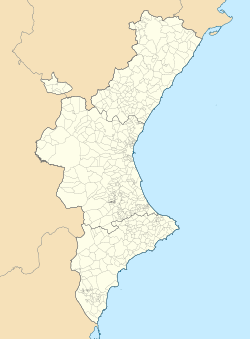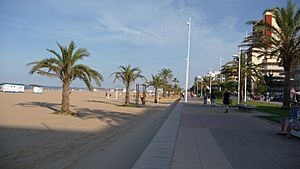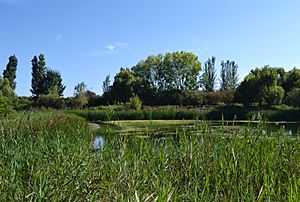Gandia facts for kids
Quick facts for kids
Gandia
|
|||
|---|---|---|---|
|
|||
| Motto(s):
Sic luceant opera tua
|
|||
| Country | |||
| Autonomous community | |||
| Province | |||
| Comarca | Safor | ||
| Judicial district | Gandia | ||
| Area | |||
| • Total | 60.8 km2 (23.5 sq mi) | ||
| Elevation | 22 m (72 ft) | ||
| Population
(2018)
|
|||
| • Total | 73,829 | ||
| • Density | 1,214.3/km2 (3,145.0/sq mi) | ||
| Demonym(s) | Gandian • gandià, -ana (Val.) • gandiense (Sp.) |
||
| Time zone | UTC+1 (CET) | ||
| • Summer (DST) | UTC+2 (CEST) | ||
| Postal code |
46700–46702, 46730
|
||
| Official language(s) | Spanish and Valencian | ||
Gandia is a city and municipality in the Valencian Community, located in eastern Spain. It sits right on the Mediterranean Sea, along the beautiful Costa del Azahar. Gandia is about 65 kilometers (40 miles) south of Valencia and 110 kilometers (68 miles) north of Alicante. You can reach the city easily by the N-332 road.
Gandia was a very important city for culture and trade in the 1400s and 1500s. It even had a university back then! Famous people like the poet Ausiàs March and the writer Joanot Martorell lived here. It's also well-known because the powerful Borgia family had a special title called 'Duke of Gandia' since 1399.
As of 2020, Gandia is one of the biggest coastal towns in Spain. In summer, its population can grow to over 200,000 people! It's a major center for shopping and tourism in its area. The city has two main parts: Gandia City and Gandia Beach. Gandia City is where you'll find all the historical buildings, shops, and daily life. Gandia Beach has apartments and summer homes, mostly used during the warm season. The beach area is also where most of the bars and nightclubs are. Like in many parts of Spain, the nightlife usually starts quite late, after midnight. The city and the beach are about 2 kilometers (1.2 miles) apart, which helps keep the summer tourism separate from the everyday life of the locals.
Contents
Discover Gandia's Culture
Gandia offers many cultural events. These include writing competitions, a Summer University, and an International Festival of Classical Music. You can also enjoy various art exhibitions. For sports, there are water activities, golf, tennis, and hiking. Gandia also hosts the yearly Cortoons Gandia animation festival in April. This festival celebrates animated films and short movies from around the world.
Explore Gandia's Tourism
With its long, wide, and golden sandy beaches, Gandia is a top tourist spot in Spain. Traditionally, most visitors to Gandia came from other parts of Spain, especially Madrid. However, in recent years, it has become more popular with international tourists, mainly from France, Germany, and the United Kingdom.
You'll find many popular Spanish restaurants near the beach. Gandia also has great shopping, including malls and big supermarkets like Carrefour, Lidl, Mercadona, and Aldi.
Main Places to See in Gandia
- Collegiate Basilica of Gandia
- Ducal Palace of Gandia
- Convent of Santa Clara of Gandia
- Archaeological Museum of Gandia
- Monastery of Sant Jeroni de Cotalba
- Route of the Borgias
- Route of the Monasteries of Valencia
- Route of the Valencian classics
Gandia's Geography and Nature
Gandia is home to an important regional wetland called Marjal de La Safor. This natural area covers over 1.2 square kilometers (0.46 square miles) on the edge of the city. It's a special place for many water plants. You can find plants like Lemna gibba and Lemna minor, and many types of water lilies, such as Nymphaea alba. Underwater plants like Myriophyllum and Ceratophyllum also grow here. On land, you'll mostly see different kinds of reeds and cattails.
Various types of palm trees have also grown naturally in the area. They are common in the wetland because their seeds are spread by wind or animals. The most common palm trees you'll see are the African date palm, Mexican fan palm, and Canary Island date palm. There are also a few native European palmetto trees, but not as many as the other types.
This natural zone is also full of animals, including many birds, fish, amphibians, and reptiles. Some mammals live here too. Common birds include little grebes, mallards, kestrels, coots, and moorhens. You might also spot fish like spined loaches and eels, and amphibians such as common toads and Iberian green frogs.
The most common reptiles are turtles. There's a native species called the European pond turtle, but it's in danger because of the spread of introduced species like the Florida turtle. Other reptiles include Moorish geckos, Iberian wall lizards, and viperine snakes.
Common native mammals in the area include European rabbits, European hedgehogs, greater white-toothed shrews, European bats, and wild hogs.
Gandia's Climate
Gandia has a Mediterranean climate. This means it has mild winters and hot summers. The average temperature throughout the year is between 18-19°C (64-66°F). Gandia gets about 600mm (23.6 inches) of rain each year, with most of it falling from September to November. Autumn is the wettest season.
Sports in Gandia
The local football team in Gandia is called CF Gandía.
International Connections
Twin Towns and Sister Cities
Gandia is connected with another city through a program called "twin towns" or "sister cities". This helps promote cultural ties and understanding.
Public Transport in Gandia
Gandia has a good bus system and two Renfe train stations. These stations connect the city with Valencia. The buses in the Gandia area are run by two companies: La Marina Gandiense and L'Urbanet.
La Marina Gandiense has two lines:
- Line 1: Connects Gandia with the nearby town of Real de Gandia (and sometimes the University).
- Line 2: Connects Gandia to the beach, which is about 5 kilometers (3.1 miles) from the city.
L'Urbanet has three main lines, though one of them has two different routes:
- Line 3: This is a circular route that starts and ends at the Renfe train station in Gandia city.
- Line 4: Goes from the Gandia train station to the San Francisco de Borja hospital.
- Line 5: This line has two different routes:
- Gandia train station - Marenys de Rafalcaid
- Gandia train station - Marchuquera
There are also bus lines that connect Gandia with nearby villages like Daimuz, Guardamar de la Safor, and Oliva. You can also take buses from Gandia to bigger cities across Spain, such as Madrid, Salamanca, Barcelona, Alicante, and Bilbao.
For train services, Gandia has two stations that link it to Valencia. Both are the end points of line C-1 from Cercanías Valencia. These stations are:
- Gandia
- Platja i Grau de Gandia (This station serves Gandia's beach, but only three trains reach it each day).
Famous People from Gandia
- León de Arroyal (1755–1813), a smart writer and poet.
- Elísabet Benavent (born 1984), a popular romance writer.
- Pablo Pallares Marzo (1987), a footballer.
See also
 In Spanish: Gandía para niños
In Spanish: Gandía para niños



